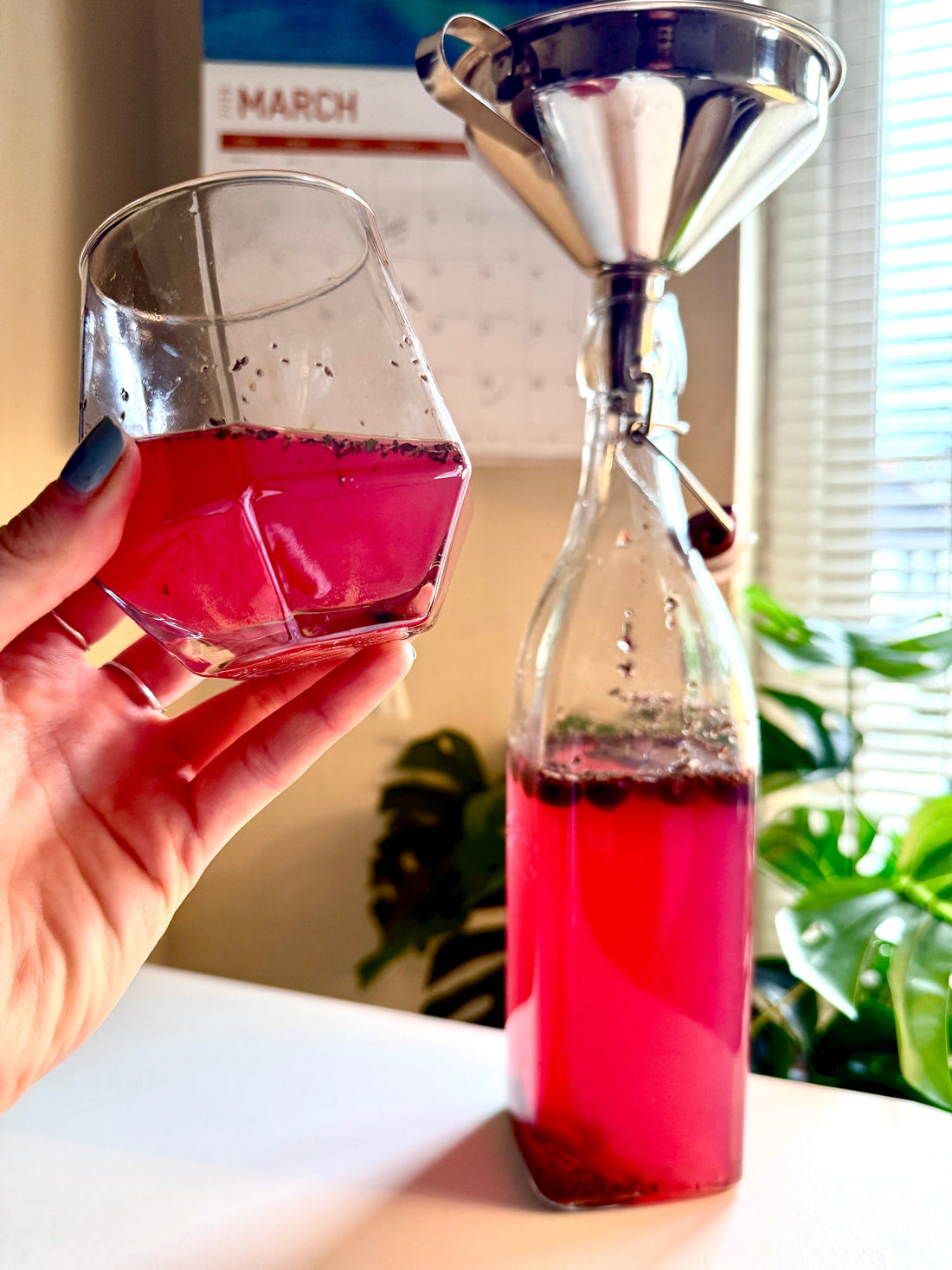Kombucha, the fizzy fermented tea known for its probiotic benefits, has been popping up everywhere in the health and wellness world, but do you know, how easy it is to make yourself at home?
Check out our beginners guide to brewing Kombucha to learn about the first fermentation, which you'll need to master before moving on to these herbal Kombucha recipes (luckily we have made sure its easy).
One of the most exciting, and fulfilling parts of brewing Kombucha is the flavouring stage, often referred to as the secondary fermentation, and that is the stage we will be talking about in this blog.
If you're looking for a beginner friendly, complete Kombucha starter kit, we have just the thing! Our starter kits are 5 star rated for their ease of use, fun extras and delicious Kombucha, right from the first brew.

Herbs have been used for centuries in teas, tinctures, and cooking for their healing and flavourful qualities. From boosting your immune system to supporting digestion and stress relief, herbs can elevate your Kombucha into a true functional beverage.
Vits and Mins
Herbs work really well in Kombucha because it is slightly acidic. This means the cell walls of the herbs can be broken down, and the flavours, colours and beneficial components such as vitamins and minerals, can be extracted.
Herbs such as mint, basil, rosemary, and lemongrass are rich in nutrients, and have flavours which sit perfectly with Kombucha, on their own or combined with fruity flavours too.
For example,
- Mint contains vitamin A and iron
- Basil is an excellent source of vitamin K
- Rosemary offers calcium and vitamin B6
- Lemongrass contains potassium and magnesium
Another major benefit is antioxidants. Many herbs are packed with compounds that help the body combat oxidative stress.
Thyme and oregano contain thymol and carvacrol, which are known for their antimicrobial and antioxidant effects.
Lavender and sage are high in polyphenols and flavonoids that may help reduce inflammation and support brain health.

When herbs are added to Kombucha, these powerful compounds are gently infused into the drink, creating a beverage that supports wellness on multiple levels.
In addition to physical benefits, certain herbs offer support for mental and emotional well-being.
Chamomile, tulsi (holy basil), and lavender are known for their calming properties.
These herbs can help reduce anxiety, regulate mood, and support relaxation, making your herbal Kombucha not just a probiotic boost, but also a stress-reducing tonic.
Ginger, peppermint, and fennel are great for digestion and help relieve bloating or discomfort, making them ideal for an after-meal Kombucha infusion.
Herbs Are Best In Secondary Fermentation
Flavouring Kombucha with herbs is a simple process. If you haven't started brewing your own Kombucha yet, check out our Complete Kombucha Starter Kit here, which includes everything you need in one nice box, and comes with a lifetime of brewing support too.
The key moment to introduce herbs is during the second fermentation.

This stage happens after your Kombucha has undergone the first fermentation, where your sweet tea is mixed with a SCOBY, the symbiotic culture of bacteria and yeast.
Once the base Kombucha has reached the desired level of tanginess, typically after 7 to 14 days, it’s time to prepare for the second fermentation.
This is where you remove the Kombucha from the fermentation vessel with the SCOBY in, and add your herbal ingredients.
You can use either fresh or dried herbs. Fresh herbs offer bright, vibrant flavours while dried herbs are more concentrated and shelf-stable.
Wash fresh herbs thoroughly and bruise or chop them slightly to release their oils. For each 500ml of Kombucha being infused, add about one to two teaspoons of fresh herbs, or half to one teaspoon of dried herbs, but be wary of any overpowering ones and add slightly less.
Pour your Kombucha into airtight glass bottles (we have the perfect ones here), leaving about an inch of space at the top.
Add the herbs to the bottles, seal them tightly, and let them sit at room temperature for two to five days.
This is when the herbs infuse their flavour into the Kombucha and the drink becomes naturally, lightly carbonated. Be sure to “burp” your bottles daily by opening them briefly to release pressure.
Once the flavour is to your liking and the bottles have a pleasant fizz, strain out the herbs and refrigerate the Kombucha.
It’s important to experiment carefully with herbs. Stronger herbs like rosemary and sage can easily overpower the drink if used in large quantities. It’s also a good idea to pair herbs with fruits or juices. Fruits not only balance the herbal notes but also provide additional sugars that help fermentation and carbonation.
For example, basil pairs beautifully with strawberries or pineapple, while mint goes well with lime or watermelon.
Now let’s look at some tried-and-true herbal Kombucha recipes.
Mint and Lime Kombucha Recipe
One of the most refreshing blends is mint-lime Kombucha. Simply add a teaspoon of fresh mint leaves and the juice of half a lime to each bottle.
Optionally, include a teaspoon of honey to encourage extra fizz. This combination is bright, cooling, and aids digestion.
Lavender and Blueberry Kombucha
Lavender-blueberry kombucha is a lovely floral drink with subtle sweetness. Add half a teaspoon of dried lavender and a quarter cup of mashed blueberries.
The lavender calms the nervous system while blueberries add antioxidants and a beautiful purple hue.
Ginger and Basil Kombucha Recipe
Or substitute the basil for fennel for extra digestion benefits.
Ginger-basil Kombucha offers a peppery twist with digestive support. Add a teaspoon of chopped fresh ginger and a few torn basil leaves.
The ginger stimulates circulation and digestion, while basil contributes its fragrant, sweet-spicy aroma and vitamin K content.

Rosemary and Orange Kombucha Recipe
For something aromatic and warming, try rosemary-orange Kombucha, or you could use grapefruit. Add half a teaspoon of fresh rosemary and a few orange slices or some orange zest.
This blend supports memory and immunity, with rosemary’s grounding pine notes balanced by the citrus brightness.
Chamomile and Apple Kombucha
Chamomile-apple Kombucha is perfect for winding down in the evening. Add a teaspoon of dried chamomile flowers and a quarter cup of apple slices or juice.
Chamomile soothes the nervous system and promotes sleep, while apples provide a mellow, naturally sweet base.
Tulsi and Lemon Kombucha Recipe
Another great stress-relief option is tulsi-lemon Kombucha. Add a teaspoon of dried holy basil and the juice of half a lemon.
Tulsi is an adaptogen, helping the body manage stress, while lemon adds a zesty, cleansing flavour.
If you’re feeling adventurous, you can start mixing and matching your own herb and fruit combinations. For example, thyme goes well with lemon or green apple, while lemongrass can be paired with ginger and mango.
We have a whole Kombucha Recipe Club dedicated to sharing, see what else we have added here.
Sage can be matched with pear or blackberry for a more savoury, earthy flavour. As always, start small, keep notes, and adjust amounts to suit your taste.
Tips For The Best Results
- Always infuse your Kombucha in glass or fermentation safe steel
- Always label your bottles with the date and ingredients so you can replicate your favourite recipes
- Don’t leave herbs in the bottles for too long after fermentation is complete, as some can become bitter over time
- Always use clean, food-safe herbs to avoid pesticides or contaminants interfering with your fermentation
Herbs are a natural and powerful way to flavour Kombucha, enhance its health benefits, and create unique, personalised drinks. Whether you’re looking for extra antioxidants, calming adaptogens, digestive support, or simply delicious flavour, herbs offer endless possibilities.
With a little creativity and care, you can transform your home-brewed kombucha into a nourishing botanical beverage that supports your wellness journey sip by sip.
Try out a few of these recipes or create your own blends. Brewing herbal kombucha isn’t just a culinary project — it’s a celebration of nature’s abundance in every bottle.


